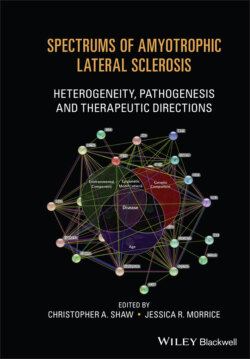Читать книгу Spectrums of Amyotrophic Lateral Sclerosis - Группа авторов - Страница 16
Site of Onset
ОглавлениеALS begins focally at a seemingly random location and progresses to involve other body regions through anatomically connected pathways and/or neighboring regions. Approximately one‐fourth of patients show initial manifestations in the muscles innervated by motor neurons residing in the medulla (bulbar onset), one‐third in the upper limb muscles, and one‐third in the lower limb muscles whose motor neurons lie in the spinal cord (spinal onset). A small proportion of patients (2–5%) show respiratory symptoms at presentation. These cases are often difficult to diagnose because the absence of additional neurological signs can be misleading. The clinical phenotype at the onset, when temporal–spatial summation hasn't yet occurred, together with additional characteristics, may be important tools to delineate peculiar phenotypes, including spinal, bulbar, pseudopolyneuritic, emiparetic, and flail‐arm forms. It remains to be clarified if these clinical pictures correspond to distinct nosological entities or are the simple consequence of stochastic phenomena.
Bulbar ALS usually presents with dysarthria and dysphagia due to a variable combination of impairment of LMNs located in the IX, X, and XII nuclei and of the corticobulbar fibers. Bulbar symptoms and signs may be the only manifestation for several months before limb symptoms occur and when only corticobulbar signs are present, the diagnosis of ALS is frequently overlooked. Bulbar onset is more frequent in females and has a worse prognosis than the spinal onset form. In pseudopolyneuritic ALS (Patrikios' disease), weakness and atrophy start in distal limb muscles with frequent absence of tendon reflexes, thus mimicking a neuropathy [11]. The flail‐arm form (Vulpian‐Bernhart syndrome) is characterized by symmetric, predominantly proximal, wasting and weakness of both arms with relative sparing of lower limbs in the initial phases. This ALS form is prevalent in males, starts after the age of 40, and shows a slightly slower disease progression than classic ALS [12, 13].
